Lights Over Lapland has a brand-new website full of exciting adventures in Abisko National Park, Sweden! Take a look at our aurora activities and book your once-in-a-lifetime trip with us today! | | |
REVERSE POLARITY SUNSPOT: New sunspot AR2720 is not only large, but also strange. Its magnetic polarity is reversed. The North and South ends of its enormous magnetic field are backwards compared to the norm for sunspots in the current solar cycle, decaying Solar Cycle 24. What does this mean? AR2720 may be the first big sunspot of the next solar cycle, Solar Cycle 25, popping up now in the middle of solar minimum. Solar cycles always mix together at their boundaries. The slow transition between Solar Cycle 24 and Solar Cycle 25 appears to be underway.
SURPRISE GEOMAGNETIC STORM: Last night, a crack opened in Earth's magnetic field. Solar wind poured in to fuel a strong G3-class geomagnetic storm. John McKinnon photographed the storm's brilliant green glow from Four Mile Lake in Alberta, Canada:
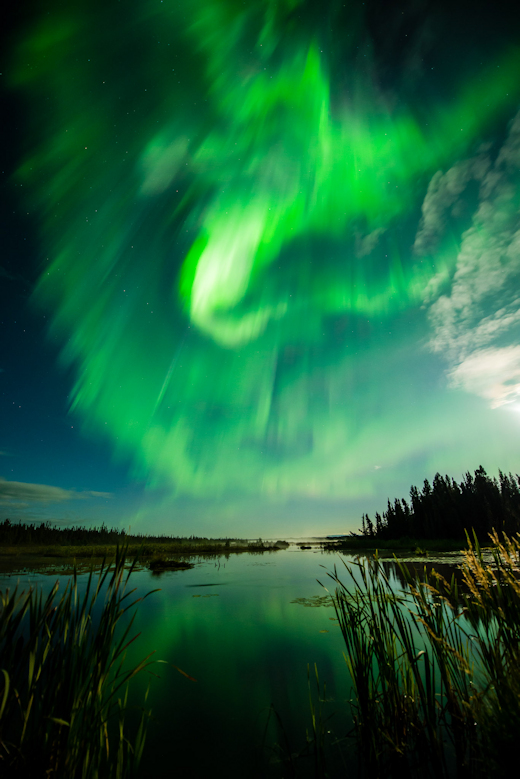
"At 2 o'clock in the morning, the auroras were so bright I could see them through the glare of the full Moon," he says.
At the peak of the storm, Northern Lights spilled across the Canadian border into US states such as New York, Montana, Michigan, and Indiana. People in Alaska witnessed a fine display as well. At the same time, Southern Lights were photographed from several locations in New Zealand.
Forecasters did not see this coming. The stage was set for the storm when a minor CME arrived with little fanfare about 24 hours ago. First contact with the CME barely registered in solar wind data, and Earth's magnetic field was unperturbed. The action began only after Earth entered the CME's wake, where strong south-pointing magnetic fields opened a crack in our planet's magnetosphere. A surprise geomagnetic storm ensured.
The storm is subsiding, but it is not over. G1- and G2-class disturbances are still ringing the Arctic Circle. This means high-latitide sky watchers should remain alert for auroras after nightfall on Aug. 26-27. Free: Aurora Alerts.
Realtime Aurora Photo Gallery
FLY ME TO THE MOONSTONE: Are you looking for a far-out gift? Nothing says "I love you" like a moonstone from the edge of space. On Jan 27th, the students of Earth to Sky Calculus flew this moonstone wrapped in a hand-crafted sterling silver Celtic love knot 35.1 km (115,158 feet) above Earth's surface:
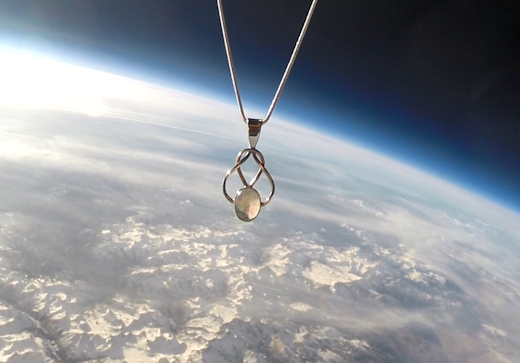
You can have it for $179.95. The students are selling these pendants to support their cosmic ray ballooning program. Each one comes with a greeting card showing the item in flight and telling the story of its journey to the edge of space. All sales support the Earth to Sky Calculus cosmic ray ballooning program and hands-on STEM research.
Far Out Gifts: Earth to Sky Store
All sales support hands-on STEM education
ATMOSPHERIC RADIATION UPDATE: Spaceweather.com and the students of Earth to Sky Calculus are in the middle of a cosmic ray ballooning campaign, visiting places we've been before to update our measurements of atmospheric radiation across the USA. On August 16th through 21st, we launched a series of balloons to the stratosphere from Bishop, CA; John Day, OR; and Wenatchee, WA. We found radiation levels increasing up and down the Pacific Coast. The latest data points are circled red:
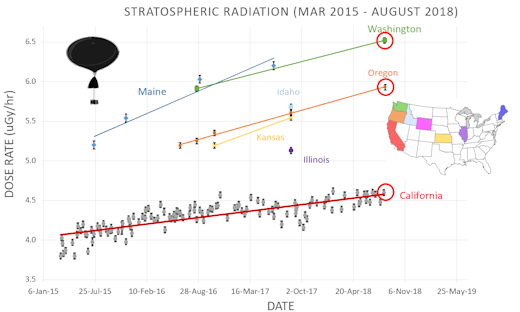
Why is cosmic radiation increasing? Mainly, it's due to the solar cycle. As the sun plunges into a deep solar minimum, the sun's magnetic field is weakening. Solar wind pressures are declining as well. As a result of these changes, cosmic rays from deep space are finding it easier to penetrate the inner solar system. Surging cosmic rays hit the top of Earth's atmosphere, creating a downward spray of secondary particles and radiation that we detect using sensors on high-altitude balloons.
Our recent balloon launches from multiple US states as well as Sweden, Norway, Chile, Mexico and New Zealand confirm that cosmic rays are intensifying everywhere, but not by the same amount in all places. For instance, in the latest data we see that atmospheric radiation above Washington is almost 50% stronger than radiation above central California--a significant difference considering that the two launch sites are separated by only ~900 miles and 10 degrees of latitude. This shows that Earth's magnetic field is an uneven shield against incoming cosmic rays, protecting some places more than others.
Next week we'll be launching a cosmic ray balloon from Kansas and, soon thereafter, from Maine to extend our monitoring across the continental USA. Stay tuned.
Realtime Space Weather Photo Gallery
Every night, a network of
NASA all-sky cameras scans the skies above the United States for meteoritic fireballs. Automated software maintained by NASA's Meteoroid Environment Office calculates their orbits, velocity, penetration depth in Earth's atmosphere and many other characteristics. Daily results are presented here on Spaceweather.com.
On Aug. 26, 2018, the network reported 25 fireballs.
(23 sporadics, 1 Northern delta Aquariid, 1 Southern delta Aquariid)
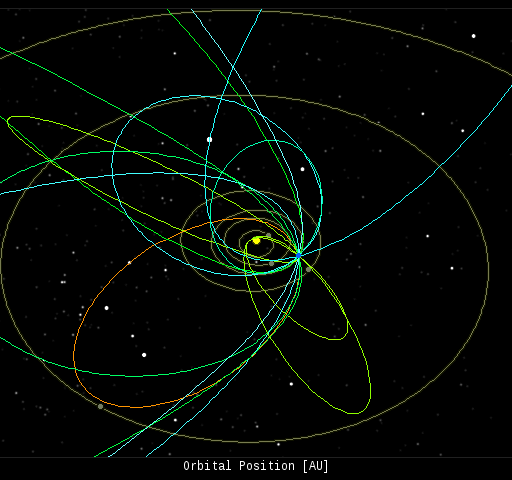
In this diagram of the inner solar system, all of the fireball orbits intersect at a single point--Earth. The orbits are color-coded by velocity, from slow (red) to fast (blue). [Larger image] [movies]
Potentially Hazardous Asteroids (
PHAs) are space rocks larger than approximately 100m that can come closer to Earth than 0.05 AU. None of the known PHAs is on a collision course with our planet, although astronomers are finding
new ones all the time.
On August 26, 2018 there were 1912 potentially hazardous asteroids.
 |
Recent & Upcoming Earth-asteroid encounters: | Asteroid | Date(UT) | Miss Distance | Velocity (km/s) | Diameter (m) |
| 2018 QA1 | 2018-Aug-21 | 12.3 LD | 11.2 | 77 |
| 2018 PK9 | 2018-Aug-22 | 17 LD | 9 | 33 |
| 2018 PW7 | 2018-Aug-23 | 11.3 LD | 10.6 | 50 |
| 2018 QF1 | 2018-Aug-23 | 18.1 LD | 14.3 | 75 |
| 2018 PU23 | 2018-Aug-23 | 7.8 LD | 1.5 | 8 |
| 2018 PR9 | 2018-Aug-24 | 18.1 LD | 14 | 46 |
| 2018 QH1 | 2018-Aug-27 | 13.2 LD | 12.5 | 27 |
| 2018 LQ2 | 2018-Aug-27 | 9.4 LD | 1.5 | 39 |
| 2016 GK135 | 2018-Aug-28 | 16.8 LD | 2.8 | 9 |
| 2016 NF23 | 2018-Aug-29 | 13.2 LD | 9 | 93 |
| 1998 SD9 | 2018-Aug-29 | 4.2 LD | 10.7 | 51 |
| 2018 DE1 | 2018-Aug-30 | 15.2 LD | 6.5 | 28 |
| 2001 RQ17 | 2018-Sep-02 | 19.3 LD | 8.3 | 107 |
| 2015 FP118 | 2018-Sep-03 | 12.3 LD | 9.8 | 490 |
| 2018 QA | 2018-Sep-03 | 17.5 LD | 20.4 | 73 |
| 2017 SL16 | 2018-Sep-20 | 8.5 LD | 6.4 | 25 |
| 2018 EB | 2018-Oct-07 | 15.5 LD | 15.1 | 155 |
| 2014 US7 | 2018-Oct-17 | 3.2 LD | 8.7 | 19 |
| 2013 UG1 | 2018-Oct-18 | 10.4 LD | 13.4 | 123 |
| 2016 GC221 | 2018-Oct-18 | 8.7 LD | 14.4 | 39 |
Notes: LD means "Lunar Distance." 1 LD = 384,401 km, the distance between Earth and the Moon. 1 LD also equals 0.00256 AU. MAG is the visual magnitude of the asteroid on the date of closest approach. | | Cosmic Rays in the Atmosphere |
SPACE WEATHER BALLOON DATA: Approximately once a week, Spaceweather.com and the students of Earth to Sky Calculus fly space weather balloons to the stratosphere over California. These balloons are equipped with radiation sensors that detect cosmic rays, a surprisingly "down to Earth" form of space weather. Cosmic rays can seed clouds, trigger lightning, and penetrate commercial airplanes. Furthermore, there are studies ( #1, #2, #3, #4) linking cosmic rays with cardiac arrhythmias and sudden cardiac death in the general population. Our latest measurements show that cosmic rays are intensifying, with an increase of more than 18% since 2015:
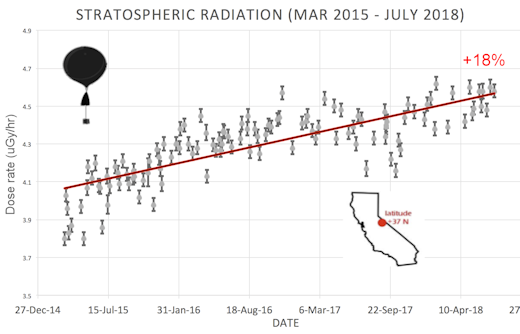
The data points in the graph above correspond to the peak of the Reneger-Pfotzer maximum, which lies about 67,000 feet above central California. When cosmic rays crash into Earth's atmosphere, they produce a spray of secondary particles that is most intense at the entrance to the stratosphere. Physicists Eric Reneger and Georg Pfotzer discovered the maximum using balloons in the 1930s and it is what we are measuring today.
En route to the stratosphere, our sensors also pass through aviation altitudes:
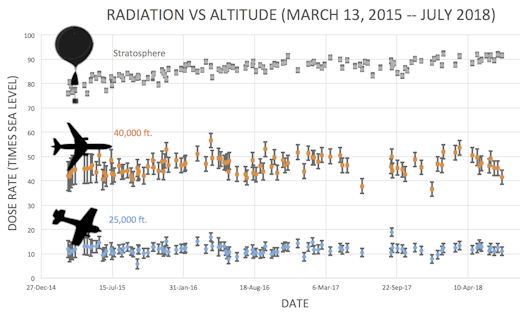
In this plot, dose rates are expessed as multiples of sea level. For instance, we see that boarding a plane that flies at 25,000 feet exposes passengers to dose rates ~10x higher than sea level. At 40,000 feet, the multiplier is closer to 50x.
The radiation sensors onboard our helium balloons detect X-rays and gamma-rays in the energy range 10 keV to 20 MeV. These energies span the range of medical X-ray machines and airport security scanners.
Why are cosmic rays intensifying? The main reason is the sun. Solar storm clouds such as coronal mass ejections (CMEs) sweep aside cosmic rays when they pass by Earth. During Solar Maximum, CMEs are abundant and cosmic rays are held at bay. Now, however, the solar cycle is swinging toward Solar Minimum, allowing cosmic rays to return. Another reason could be the weakening of Earth's magnetic field, which helps protect us from deep-space radiation.
| | The official U.S. government space weather bureau |
| | The first place to look for information about sundogs, pillars, rainbows and related phenomena. |
| | Researchers call it a "Hubble for the sun." SDO is the most advanced solar observatory ever. |
| | 3D views of the sun from NASA's Solar and Terrestrial Relations Observatory |
| | Realtime and archival images of the Sun from SOHO. |
| | from the NOAA Space Environment Center |
| | fun to read, but should be taken with a grain of salt! Forecasts looking ahead more than a few days are often wrong. |
| | from the NOAA Space Environment Center |
| | the underlying science of space weather |
 | If you are a Youtuber and want to buy real Youtube views than try out Buyrealsocial.com for the best results possible! |
 | To find reviews of new online casino sites in the UK try The Casino DB where there are hundreds of online casino reviews complete with bonuses and ratings. |
| | These links help Spaceweather.com stay online. Thank you to our supporters! |
| | | | | | |

